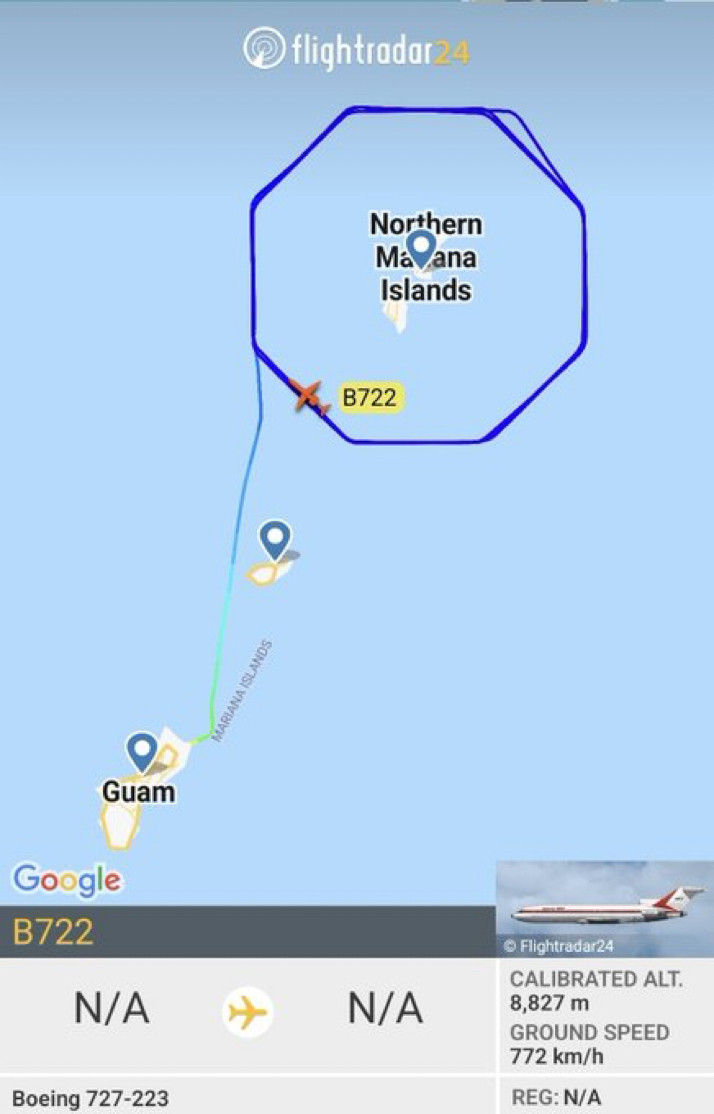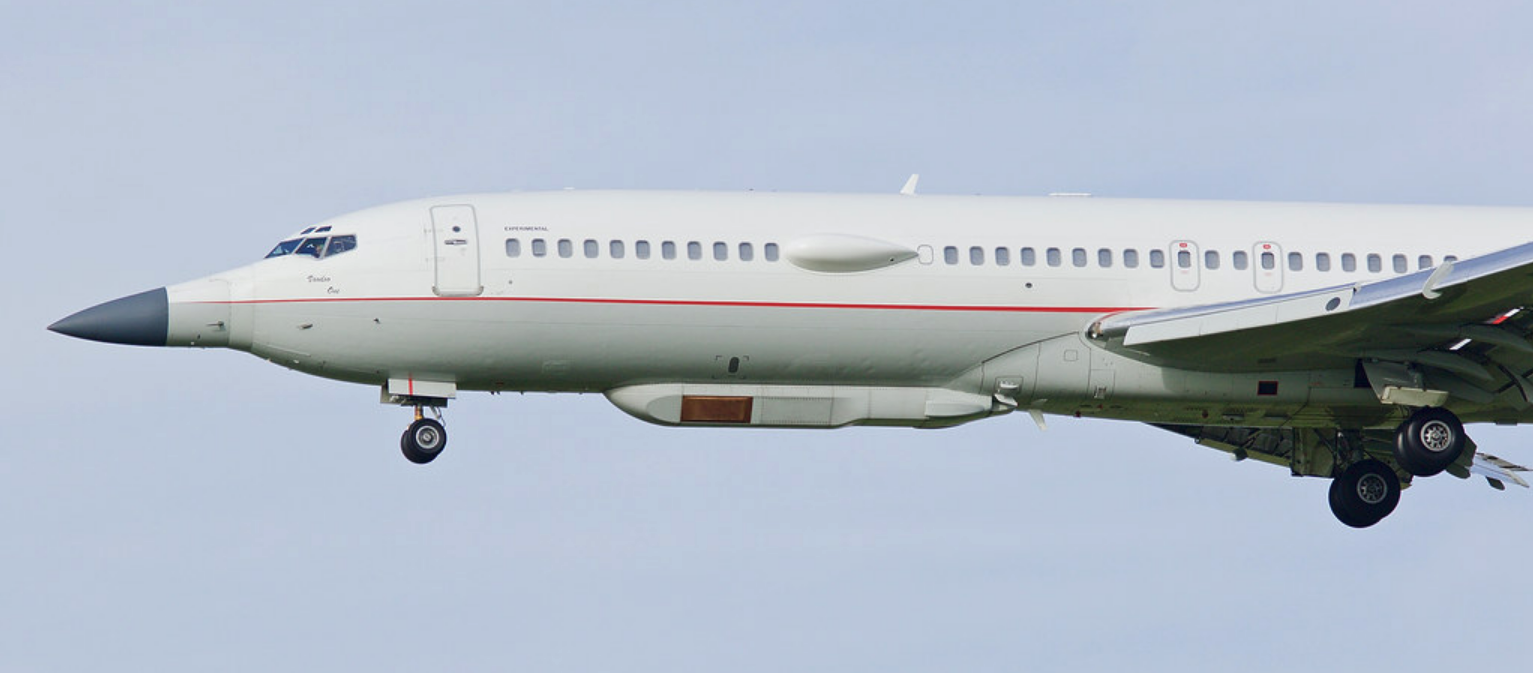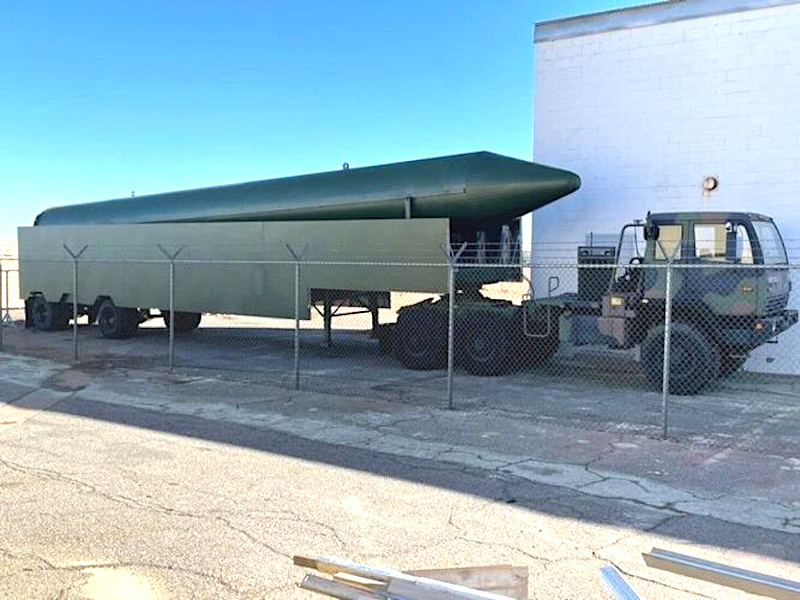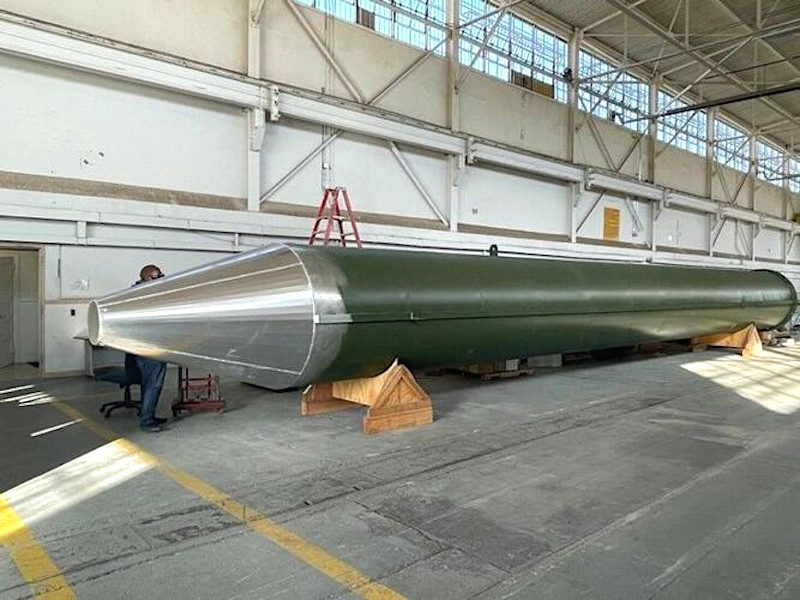A unique Boeing 727 testbed jet, which belongs to U.S. defense contractor Raytheon, was tracked flying an unusual octagon-shaped orbit around the islands of Saipan and Tinian in the past 24 hours during a very rare trip to the Western Pacific region. Raytheon has confirmed to The War Zone that the aircraft is taking part in a series of experiments associated with a major U.S. military exercise that is taking place now on and around these islands involving forces in the air, at sea, and on the ground.
The highly modified California-based Boeing 727, which carries the U.S. civil registration code N289MT and typically operates using the callsign “Voodoo 1,” conducted the flight around Saipan and Tinian from the U.S. Air Force’s Andersen Air Force Base on Guam. Saipan and Tinian are both U.S. territories that are part of the larger Commonwealth of the Northern Mariana Islands (CNMI). Guam is also a U.S. territory, but is not part of the CNMI. All three islands have strategic significance, which has only grown in recent years as the U.S. military has focused its attention on responding to potential threats and other challenges that China poses in this region, as well as elsewhere in the world.

N289MT was previously spotted arriving at Misawa Air Base in Japan, which is home to various forward-deployed U.S. military units, on June 1. The Raytheon test aircraft had left its home at Ontario International Airport in California on May 30, and then stopped along the way at Fairchild Air Force Base in Washington State and on the island of Adak in Alaska’s Aleutian Island chain.
Voodoo 1 is a key test asset for Raytheon. It has historically been mostly associated with the development of advanced radars, which it can carry on flight tests in its distinctly modified nose, which is basically that of an F-15 Eagle. This includes work on the AN/APG-63 series of Eagle radars, and more recently, the AN/APG-82 Active Electronically Scanned Array (AESA) type, versions of which are used on the Air Force’s new F-15EX Eagle II fighters and are being integrated onto existing F-15E Strike Eagle combat jets. Air Force B-52H bombers are also set to receive a variant of the AN/APG-82 as part of a radar upgrade program.

Just a year ago, The War Zone asked the head of the F-15 radar program for Raytheon, Michelle Styczynski, about Voodoo 1 and how it plays into the company’s developmental initiatives. Here is that exchange:
Tyler: What is the APG-82’s lineage in relation to other Raytheon products, including outside of the F-15? Where does that lineage come from? And one oddball part of this—how did ‘VOODOO1,’ your 727 testbed jet, play a role in developing this new radar?
MS: Yeah, what a great question. So what Raytheon is really good at is obviously trying to provide cost-reduction alternatives for customers. What you’re getting from the APG-82 is actually born from the APG-79 radar that’s on the F-18 and also the legacy APG-63V3 that sits in the F-15C/D aircraft. Essentially, both of those radars came together to create the APG-82. We leveraged all of those different developments in order to get this latest APG-82V1 radar.
With regards to the [727] aircraft, that’s our RMT [Raytheon Multi-program Testbed] platform. That airplane has definitely given us a leg up in terms of testing out the different developments that we do. We use that aircraft to essentially take what we do in our lab and put it into the sky before it gets into a fighter test jet. We can test certain things and work out any bugs that we may see, so it helps with cycle time as far as development is concerned, and we also try to cut costs for our customers by doing so. We have definitely done this on our domestic developments and are doing this on our international developments… It is a really big part of how we cut down development cycle time to get the customer faster technology quicker.
Tyler: Is there an F-15 cockpit in there? How does the 727 act like an F-15?
MS: Yeah, there are different simulators. I don’t have the specifics with regards to that, but I do know that we do have different simulators that… What’s the word? Well, that simulate… I keep using the word simulator over and over again but it simulates the ADCP II (Advanced Display Processor II) from Boeing, there are simulations on a nav that we would get… and so it’s just a giant flying simulator in my mind. But I’m probably not doing it as much justice as I could because that thing has been providing us a significant amount of lift across multiple programs to get things done.
Teams are actually looking at capacity across the Raytheon technology portfolio to continue to exploit the legs up that we do get in our development to expand that further in terms of investing for more aircraft… Because that airplane in itself right now has very little capacity with all the work that it’s doing… So it’s definitely being put to use by our customers.
Raytheon’s Boeing 727 testbed also has a detachable ventral gondola-type fairing under the forward fuselage that could accommodate various kinds of sensors, such as radars with synthetic aperture imaging functionality and multi-spectral cameras, and other subsystems. Pictures from plane spotters in Japan, as well as those in the United States that caught the aircraft flying near Salt Lake City and around southern California earlier this year, show the gondola configuration. The Japan images suggest the presence of a low-observable AESA radar or some other type of conformal sensor in a rhombus aperture on the right side of the pod. Larger array, or at least a discolored panel, is on the opposite site.
“Raytheon’s Multi-Program Testbed, a modified Boeing 727, is participating in a number of experiments associated with Valiant Shield 22, a U.S.-only, biennial field training exercise in the Indo-Pacific region focused on the integration of joint training in a multi-domain environment,” a spokesperson for Raytheon Intelligence & Space told The War Zone. “Given operational security considerations, we cannot provide additional details on the nature of these experiments at this time.”
Valiant Shield 22 is the latest iteration of this biennial exercise. This set of large-force field drills, which officially kicked off on June 6 and is set to conclude at the end of next week, includes various training activities on and around Saipan and Tinian.
“The joint forces training exercises on Tinian will involve maritime operations at Tinian Harbor, logistical hub staging activities at the San Jose Port, refueling supply point operation at the Tinian West Field while cargo airdrop delivery systems will occur on North Tinian Drop Zone,” according to a press release from the CNMI’s Bureau of Military Affairs, as republished by the Marianas Variety newspaper in May.
The training on Saipan is more involved and includes the use of four 55-foot-long simulated enemy road-mobile ballistic missile launchers, pictures of which are seen below, among other things. Unsurprisingly, the mock ballistic missiles have a general look that is vaguely similar visually to various Chinese types, such as the DF-21 and DF-26, which are of particular concern to U.S. military planners. Detecting and being able to enact a kill chain to destroy these types of missiles would be key during an actual conflict with China or another state with robust ballistic missile capabilities.


The CNMI Bureau of Military Affairs’ May press release said that “this piece of the training activities is intended to refine defense communication capabilities.” This could refer to testing and evaluation regarding the exchange of targeting information, as well as just general communications capabilities in support of operations targeting high-value targets like an opponent’s mobile ballistic missile forces.
The orbit that N289MT was tracked flying around Saipan and Tinian could align with a test of one or more sensor systems, with the mock ballistic missiles potentially being among the targets of interest. The experiments that the aircraft is supporting could involve new or improved communications and data-sharing suites, as well. The U.S. military, as a whole, is only increasingly interested in ways to gather a wide array of information, fuse it together and otherwise process it, and then disseminate it to where it can do the most good, and do so as quickly as possible. Testing of advanced networking capabilities is an ever-more central part of major U.S. military exercises across the board.
Beyond that, conducting whatever these experiments might be in association with Valiant Shield 22 can only offer a valuable opportunity to see how whatever systems are on board Voodoo 1 perform in large force scenarios. This exercise in particular is taking place in a real-world environment that is exactly where a further high-end conflict might occur, too.
More details about Voodoo 1’s flight from Guam, or at least hints as to exactly what the aircraft may have been doing, may well come as Valiant Shield 22 proceeds or in official news about the exercise after it wraps up.
Special thanks to Twitter user @Righardt23 for bringing this flight to our attention.
Contact the author: joe@thedrive.com and tyler@thedrive.com
